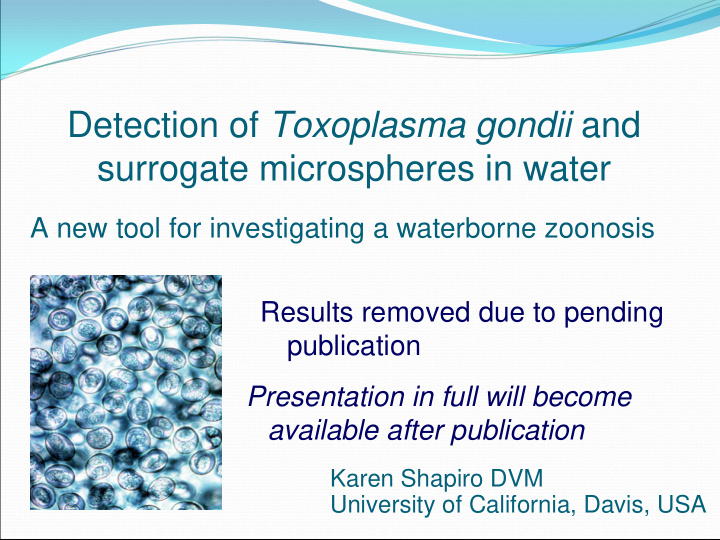



Detection of Toxoplasma gondii and surrogate microspheres in water A new tool for investigating a waterborne zoonosis Results removed due to pending publication Presentation in full will become available after publication Karen Shapiro DVM University of California, Davis, USA
Background: Waterborne Disease � A leading cause of death world-wide � Developing nations � 3.4 Million deaths annually � 1.8 Million children � Ingestion of pathogens in contaminated water � Viruses � Bacteria � Parasites
Introduction: Toxo � Toxoplasma gondii (Toxo) � Zoonotic protozoan parasite � Infects humans and animals � Agent of toxoplasmosis � Global distribution Toxo oocyst
Introduction � Toxo – Life cycle � Cats definitive hosts � Many warm blooded animals as intermediate hosts � Transmission routes � Oocyst ingestion � Undercooked meat � Congenital
Toxo in People � Infection subclinical in 90% of healthy adults � Life long infection � Human exposure � US: 20% � Israel: 40-75% � France: 70% � Brazil: >90% David Ferguson, Oxford University
Human Toxoplasmosis � Healthy adults – 10% � Fatal disease in Immunocompromised � Children of women infected during pregnancy � Myeloencephalitis � Birth defects � Retardation � Pneumonia � Blindness � Schizophrenia Healthy adults at risk from waterborne infection
Waterborne Toxoplasmosis Outbreaks Canada, 1995 India, 2004 Panama, French 1979 Guyana, 1998 Brazil, 2002
Waterborne Toxoplasmosis: Oocyst Transmission � Contamination of waterways with cat feces � Sewage � Point source: Storm drains � Runoff: Non-point source pollution
Waterborne Toxoplasmosis: Oocyst Resistance � Chemical Bleach Iodine Ozone Ethanol X � Physical X X X � Environmental persistence: X Formalin � Survival in soil 18 mo � Survival in water 54 mo X Salinity X X X Freezing Ultraviolet X radiation Desiccation Radio frequency
Waterborne Toxoplasmosis: Prevention � Lack of effective chemical disinfectants � Prevention measures: � Identify high risk zones � Where do oocysts enter the watershed? � Where do oocysts accumulate ? � Remove Toxo oocysts � Filtration � Coagulation � Wetlands Classic transport and fate questions… BUT HOW?
Does urbanization lead to increased contamination of waterways with Toxo? � Increased domestic cat population � Increased impervious surfaces � Storm drains � Reduction of natural wetland habitats
Thank You Thank You Funding: NIH EID Our team: Veterinary Medicine: Patricia Conrad, Heather Fritz, Jonna Mazet, Ann Melli Environmental Engineering: Stefan Wuertz, Alexander Schriewer Chemistry : Timothy Patten, John Ell, Robert Zasoski Hydrology: Wes Wallender Particle Analysis Laboratory: William Bernt
Recommend
More recommend